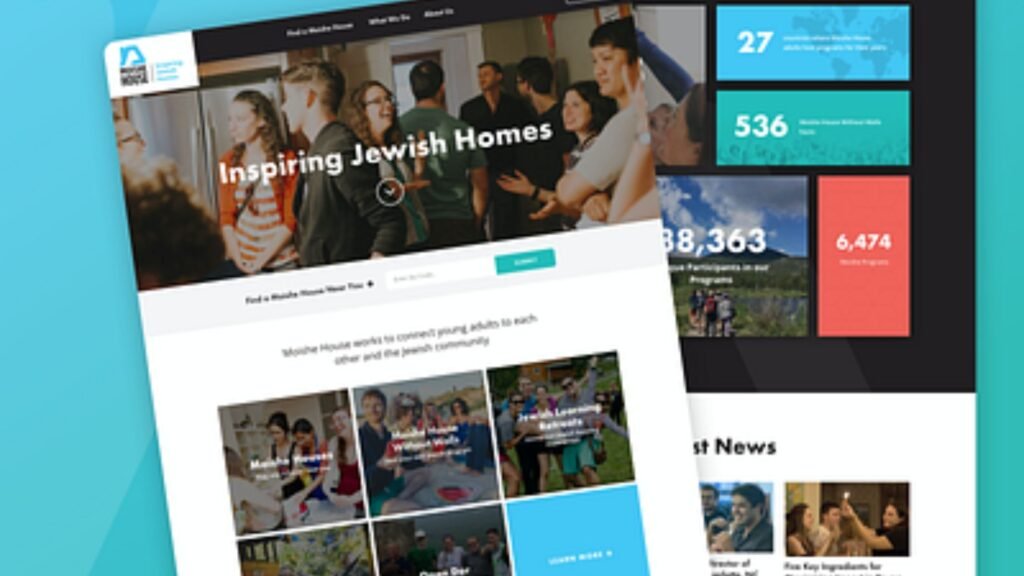Jewish web design uniquely intertwines faith with functionality, creating a space that not only reflects religious values but also meets practical user needs. Balancing cultural significance with modern usability is crucial for effectively engaging visitors and enhancing their online experience. This blog post delves into how Jewish web design can harmonize religious principles with functional design elements, offering insights into creating websites that are both spiritually meaningful and highly functional.

Faith-Based Design Elements
Incorporating Jewish Symbols
Religious Significance: Including traditional Jewish symbols such as the Star of David, menorahs, or Torah scrolls in the website’s design helps convey religious identity and heritage. These elements should be integrated thoughtfully to respect their cultural significance while enhancing the visual appeal of the site.
Symbolic Color Schemes: Utilize color schemes associated with Jewish traditions, such as blue and white. These colors can be incorporated into the design to reinforce the site’s cultural context and create a visually cohesive experience.
Hebrew Text and Religious Imagery
Cultural Authenticity: Incorporate Hebrew text and traditional calligraphy to reflect the linguistic and artistic aspects of Jewish culture. Ensure that Hebrew text is used appropriately and accompanied by translations or explanations to accommodate all users.
Religious Imagery: Use religious imagery, such as scenes from Jewish holidays or historical events, to enrich the site’s content. These visuals can help communicate the significance of various aspects of Jewish life and traditions.
Functional Design Considerations
User-Friendly Navigation
Clear Structure: Design a website with a clear and intuitive structure to ensure that users can easily find the information they need. Use well-organized menus, search functions, and straightforward navigation to enhance usability.
Accessible Design: Ensure that the website is accessible to all users, including those with disabilities. Implement features such as keyboard navigation, screen reader compatibility, and text-to-speech options to create an inclusive experience.
Mobile Optimization
Responsive Design: With the increasing use of mobile devices, ensure that the website is responsive and performs well on various screen sizes. A mobile-optimized design allows users to access content seamlessly, whether on a smartphone, tablet, or desktop computer.
Touch-Friendly Elements: Design touch-friendly interactive elements, such as buttons and links, to ensure that they are easy to tap on mobile devices. This enhances usability and prevents frustration for users navigating the site on touchscreens.
Balancing Faith and Function
Integrating Religious Practices with Modern Features
Prayer and Ritual Tools: Incorporate tools that support religious practices, such as prayer times, Torah readings, or holiday calendars. These features provide practical benefits while aligning with the site’s religious focus.
Educational Resources: Offer educational content related to Jewish practices and teachings, such as articles, videos, or interactive modules. Ensure that these resources are well-organized and easy to access, enhancing their usability and impact.
Community Engagement and Interaction
Social Media Integration: Integrate social media feeds and sharing options to connect with users on platforms they frequently use. This feature helps extend the reach of the site and fosters community engagement.
Interactive Features: Include interactive elements such as forums, discussion boards, or event registration tools to encourage user participation. These features create opportunities for community building and interaction within the context of the site’s religious focus.
Case Studies of Effective Integration
Case Study 1: The Jewish Museum’s Digital Experience
Overview: The Jewish Museum’s website integrates religious and cultural elements with modern functionality. Features include virtual tours, interactive exhibits, and educational resources.
Faith and Function: The site incorporates traditional Jewish symbols and imagery, while offering user-friendly features such as interactive exhibits and educational materials. This combination enhances both the cultural and practical aspects of the site.
Case Study 2: My Jewish Learning’s Educational Platform
Overview: My Jewish Learning provides a digital platform with modular learning units and interactive quizzes.
Faith and Function: The site balances faith-based content with modern educational tools. It offers a user-friendly interface and personalized learning paths, making Jewish education accessible and engaging for users.
Conclusion
The intersection of faith and function in Jewish web design involves creating a website that honors religious traditions while providing practical, user-friendly features. By incorporating culturally significant elements, ensuring accessibility, and integrating modern design trends, you can create a site that both reflects Jewish values and meets the needs of its users. Balancing these aspects ensures that the website is not only spiritually meaningful but also functional and engaging, fostering a deeper connection between users and their heritage.




